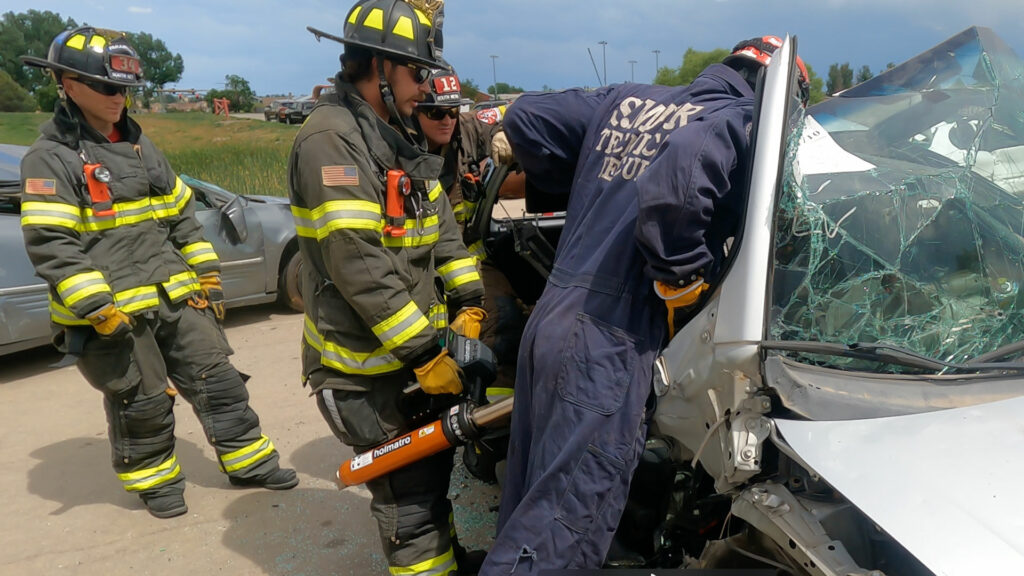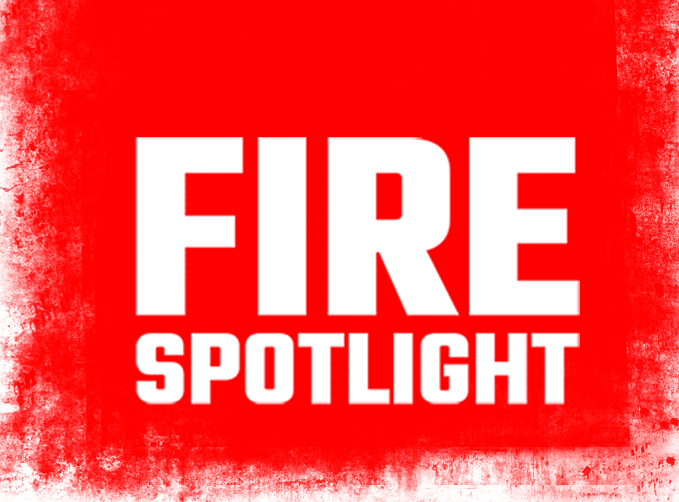FIREFIGHTERS LEARN SPECIFIC VEHICLE STABILIZATION TECHNIQUES TO HELP DURING VEHICLE EXTRICATION.
Parker Fire College puts firefighters through vehicle stabilization training. Firefighters learn specific vehicle stabilization techniques to help during vehicle extrication. They train using rescue struts and the X-Bracing technique.

VIDEO TRANSCRIPTION:
What we’re trying to do is just make sure that the car doesn’t move around, in case somebody is in it.
This one’s probably not too bad.
If you are in the car, upside down or you’re kind of hitting the sides and us moving that thing around is not fun.
Anytime we were going to use rescue 42s, we go by the phrase when in doubt cheat out. That means we want a nice wide platform. Once we’re done, we’re going to look at the car and we want to see a nice big triangle.
Anytime we were going to use rescue 42s, we go by the phrase “when in doubt cheat out“. That means we want a nice wide platform.
INSTRUCTOR TIP
A triangle is a very strong shape. We want the base of the struts to be far out, we’re going to tie it together with a strap and we’re going to use a chain to cradle the car and make sure it’s held by that system. Keep it nice and wide and there are angles that we will use for this. I’ll get into that more when I get into my space.
CHAINS
There are a couple of different ways we can do this. You can just run the chain all the way through the back of the car. You can envision it, the chain goes this way and then out on the other side, then we’ll attach our struts to the chain, and use the chain as a saddle to pick up the car. Sometimes that works really well, sometimes it doesn’t work very well.
We have to address the fact that at some point they’re going to do, what’s called an inverted depress blowout. They’re going to need to take all this out while we’re upside down. If we throw the chain in there, it could hinder that. sometimes if I’m not thinking about the fact that they might have to do that, I’ll just throw the chain in there and it is what it is.
We’ll have to address it, cutting around it and making sure we’re not compromising the strength of the car itself.
I can do this a couple of ways. I could grab the spreader from over there or I could just bend it a little bit. Grab that chain and pass it through to the other side. If there are people in the back seat, this may not be the best option because you could be putting the chain on top of them.
STRUTS
We’re going to expand those struts and take the pins. Usually what I do is I’ll pull the head, and it will start to pull the blue out too. Make sure blue is first and then transition to white.
The struts can give you the ability to lift the car but that’s not something I’m going to get into too much right now. Once you go over here and we’ll talk about it. When you’re thinking of that concept of being able to cheat out with a wide form on your struts, it probably is a little bit better to have a slightly larger strut.
Well, I’m just going to go one hole on the whites, and then we’ll go ahead and pin one thing there and one chain. Red through white and white through blue, and then we’ll do the same on that.
All right now, we’re going to take that to the side.
Leave it there for now. Come on over here. And we’ll talk about putting the chain in.
Laterally, the struts have very little, if any strength. They are meant to be loaded under compression. They are very strong under compression. If you push laterally on the side, the whole bar will fail quickly.
That’s important because if I were to start loading the side of it, like this, we’ll snap the head off. It’s one of those things you have to be mindful of.
When you are putting a chain on the strut, put the welded piece close to the strut. Every link has a weld in it. Even the grade eight and grade 10 set up has a weld in it and we try to put the weld away. It’s just one of those things where we try to use the strongest part of the chain closest to the strut.
“When you are putting a chain on the strut, put the welded piece closest to the strut.”
INSTRUCTOR TIP
In this operation, we would have one person setting up on this side, one person setting up on the other side to throw the strap on B, connect and go. We are going to do the same thing on the other side.
STRAPS
Make sure the straps are in line. If they’re not in line, we could have some, some issues and have one of these get kicked out.
When we’re dealing with ratchet straps, these are rated for a lot of weight. Approximately 3,000 pounds, but only when the ratchet is closed. We’ll make sure that that ratchet is completely closed and make it nice and neat by putting the remainder of the drop on top.
X BRACING
So now this vehicle is fairly stable. In most cases, this is all you need. On SUVs and taller vehicles, there are times when you’ll have good stability in this setting, but it’s just not quite enough on taller vehicles. You still have a little bit of a lateral movement because the vehicle is so tall and its center of gravity is a little bit off, or it might just be teetered toward the front of the car.
What we can do is called X bracing. You’re going to go underneath and hook up to that thing. Crank it a couple times to get a little bit of tension.
The purpose of the X bracing is just to take the lateral movement out of it. You’re not really doing much in terms of stability of the car but we are pulling the struts in a way that keeps it from moving up and down.
It’s in good shape.Now the caveat to using these is you do on occasion as you guys saw live with risk before, these end with straps. But when we’ve got X bracing on, do not attempt to lift because essentially what we’ve done is we’ve tied the car down to the straps. If we try to lift right now, we’ll be pressurizing the straps.
The trunk on this one and everything else kind of makes this one a little bit challenging, but realistically, this is good enough. We don’t have to be super tight. They don’t have to be like a piano string. We are just trying to take the lateral rock out of the whole system.
The other thing that I want to do is if we do have passengers in the backseat, you guys will all take a look and see where that chain is. Look at where the chain is running right now. We’re not going to be able to run the thing through the car, but we’re going to have to do is basically a choker, so instead of the saddle, we’re going to essentially wrap the C post around the post itself and then put the strut in the back. That’s a good alternative method of stabilization.
